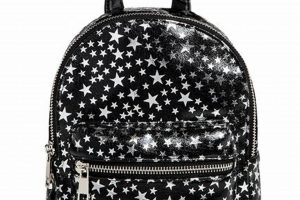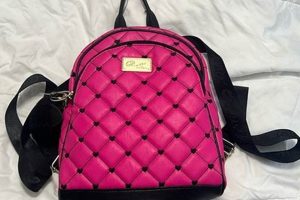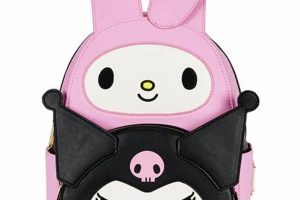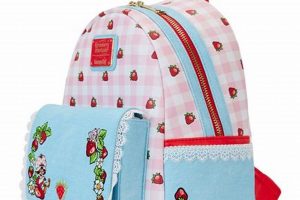A compact carrying solution designed for individuals seeking a smaller alternative to standard-sized bags. These items provide sufficient space for essential belongings while maintaining a lightweight and easily portable form factor. For example, one might use such an item to carry a water bottle, wallet, phone, and a small book.
The utility of this type of bag resides in its balance between capacity and convenience. It allows for efficient transport of necessities without the burden of a larger, heavier bag. Historically, smaller carrying solutions have been popular among students, travelers, and those participating in outdoor activities where agility is important. They promote minimalism and streamline daily routines.
The following sections will delve into the specific materials, design considerations, and intended uses relevant to these articles.
Essential Considerations for Selecting a Compact Backpack
This section outlines crucial aspects to consider when choosing a small backpack. Attention to these details ensures optimal utility and longevity of the item.
Tip 1: Prioritize Durable Materials: Examine the fabric composition. Reinforced nylon or polyester offers greater resistance to tears and abrasions compared to standard fabrics. Check the denier rating, with higher numbers indicating denser and more durable materials.
Tip 2: Evaluate Stitching Quality: Reinforcements at stress points, such as strap attachments and zipper areas, are vital. Inspect the stitching for consistency and tightness. Double-stitched seams significantly enhance durability.
Tip 3: Assess Zipper Construction: Opt for heavy-duty zippers, preferably those made of metal or high-quality coil zippers. Ensure the zipper teeth align smoothly and that the zipper pull operates without resistance. A zipper cover can provide additional protection from the elements.
Tip 4: Consider Organizational Features: Internal pockets and compartments aid in efficient packing and prevent items from shifting during transit. Look for dedicated sleeves for tablets or small electronic devices.
Tip 5: Examine Strap Design: Padded shoulder straps and a sternum strap contribute to comfortable weight distribution, particularly when carrying heavier loads. Adjustable straps allow for customization to individual body types.
Tip 6: Analyze Water Resistance: A water-resistant coating or lining can protect the contents from light rain or spills. Note that “water-resistant” differs from “waterproof;” for complete protection in heavy rain, consider a separate rain cover.
Tip 7: Check Weight and Dimensions: Before purchasing, verify the empty weight of the backpack. Even small differences in weight can impact comfort, especially when carrying the bag for extended periods. Ensure the dimensions comply with any size restrictions relevant to travel or specific activities.
Selecting a small backpack requires careful assessment of its construction, materials, and features. By attending to these details, individuals can acquire a reliable and versatile carrying solution tailored to their needs.
The subsequent sections will present more comprehensive insights into the applications and maintenance of compact backpacks.
1. Compact Dimensions
The defining characteristic of this carrying solution is its reduced size, influencing various aspects of its design, functionality, and suitability for specific applications. The following points highlight the critical facets of its compact dimensions.
- Portability and Maneuverability
Smaller size directly correlates to increased ease of transport. Compact dimensions allow for unencumbered movement in crowded environments and reduce strain during extended wear. For example, it is easily stowed under aircraft seats or in overhead compartments, streamlining travel experiences.
- Capacity Considerations
The reduced size inherently limits the volume and weight it can accommodate. Users must prioritize essential items. This encourages mindful packing and discourages overpacking, promoting a lighter load. The volume capacity, typically measured in liters, dictates the carrying capabilities.
- Aesthetic and Profile
Compact proportions contribute to a streamlined and less obtrusive aesthetic. A smaller profile is often perceived as more stylish and professional, especially in urban settings. The bag’s dimensions can influence its overall visual appeal and perceived suitability for diverse occasions.
- Activity-Specific Adaptability
The compact form factor makes the carrying solution well-suited for activities requiring agility and minimal bulk. It is often favored for hiking, cycling, or attending events where larger bags are impractical or restricted. Its dimensions accommodate the essential gear needed for focused activities.
The compact dimensions of this carrying option represent a deliberate compromise between capacity and portability. This trade-off makes it a practical choice for individuals prioritizing convenience, minimalism, and unencumbered movement. The specific dimensions impact its applicability to various contexts and activities, shaping its overall value proposition.
2. Durable Construction
Durable construction is a critical element in the overall value proposition of a compact bag. Given the intended use case frequent carry of essential items in diverse environments a robust build directly impacts the lifespan and reliability of the item. Substandard materials and weak construction undermine the bag’s utility, potentially leading to premature failure and the loss or damage of its contents. Therefore, the selection of appropriate materials and the implementation of reinforced construction techniques are paramount.
The connection between robust build and longevity is straightforward. For instance, a compact bag constructed with high-denier nylon and reinforced stitching at stress points is demonstrably more resistant to tearing and abrasion than one utilizing lightweight, unreinforced materials. Similarly, the use of quality zippers and buckles minimizes the risk of breakage, ensuring the bag remains functional over extended periods. In practical terms, this translates to reduced replacement costs and a more sustainable consumption pattern. Consider the instance of a student who carries textbooks and a laptop daily; a poorly constructed bag will likely fail within a single academic year, while a durable model could withstand multiple years of use.
In summary, durable construction constitutes a fundamental requirement for a functional compact bag. It directly influences its longevity, reliability, and ultimately, its value. Overlooking this aspect can lead to a compromised user experience and increased expenses in the long term. Investing in a well-constructed item ensures it can withstand the rigors of daily use and provide years of reliable service.
3. Lightweight Design
A key attribute of the compact bag is its lightweight design, a feature inextricably linked to its utility and overall appeal. The intentional minimization of weight directly impacts user comfort, portability, and the practical applications for which the item is suitable. This design consideration involves material selection, structural engineering, and the elimination of unnecessary components. Failure to prioritize lightweight construction can negate the benefits of a smaller form factor, rendering the item cumbersome and less versatile.
The impact of lightweight construction extends beyond mere convenience. For example, individuals engaged in activities such as hiking or cycling require gear that minimizes physical strain. A lighter bag reduces energy expenditure and allows for sustained performance over longer durations. Similarly, in urban environments, a lightweight bag facilitates easier navigation of crowded spaces and reduces fatigue during daily commutes. Consider the difference between a bag made with heavy canvas versus one constructed from ripstop nylon; the weight differential can be substantial, directly affecting user comfort and mobility. The strategic use of lightweight materials, such as aluminum or carbon fiber in structural elements, further contributes to weight reduction without compromising strength.
In conclusion, lightweight design is not merely a desirable feature but a critical component of a functional compact bag. It enhances user experience, expands the range of practical applications, and contributes to overall portability and comfort. Ignoring this aspect compromises the very essence of a compact bag, diminishing its value and utility. Therefore, a conscientious evaluation of weight should be a primary consideration when selecting such an item.
4. Water Resistance
The water resistance of a compact bag serves as a crucial protective barrier against environmental moisture, safeguarding the contents from potential damage. In the context of a small carrying solution, where essential items such as electronic devices, documents, or personal belongings are often stored, the ability to repel water becomes a significant functional advantage. A lack of water resistance can lead to irreparable harm to sensitive items, rendering the bag less versatile and reliable in variable weather conditions.
For example, consider a student commuting to campus on a rainy day. A bag without water resistance could allow moisture to seep in, damaging textbooks or electronic devices. Conversely, a bag featuring a water-resistant coating or lining would provide a degree of protection, preventing moisture from reaching the contents. Similarly, during outdoor activities, sudden rain showers are common. A water-resistant bag offers peace of mind, knowing that the contents are shielded from the elements. The degree of water resistance can vary, ranging from a basic repellent coating to waterproof materials and sealed seams. The choice depends on the anticipated level of exposure and the sensitivity of the items being carried.
In summary, water resistance constitutes a vital feature for these compact bags, enhancing their versatility and reliability in diverse environments. While not always providing complete waterproof protection, it offers a critical level of defense against moisture damage, ensuring the safety and preservation of essential contents. A careful consideration of water resistance is therefore essential when selecting a compact bag intended for regular use in unpredictable conditions.
5. Ergonomic Straps
Ergonomic strap design plays a crucial role in the functionality and user experience of compact backpacks. These straps influence weight distribution, comfort, and overall usability, directly affecting the wearer’s physical well-being during periods of extended use.
- Weight Distribution and Load Management
Ergonomic straps are engineered to distribute the weight of the backpack evenly across the shoulders and back. This minimizes localized pressure points and reduces the risk of strain or discomfort. For instance, wider straps with adequate padding can prevent digging into the shoulders, while adjustable sternum straps further stabilize the load. Proper weight distribution mitigates fatigue and promotes better posture, particularly when carrying heavier loads.
- Adjustability and Customization
The ability to adjust strap length and configuration is essential for accommodating varying body sizes and shapes. Ergonomic straps typically incorporate adjustable buckles and sliders, allowing users to fine-tune the fit for optimal comfort and support. This customization ensures that the backpack sits properly on the back, preventing it from swaying or shifting during movement. A properly adjusted strap system enhances stability and reduces the risk of injury.
- Padding and Material Selection
The materials used in ergonomic strap construction significantly impact comfort and breathability. Padded straps cushion the shoulders and prevent chafing, while breathable fabrics such as mesh promote airflow and reduce perspiration. High-density foam padding provides superior support and shock absorption, minimizing the impact of the load on the wearer’s body. Strategic material selection contributes to a more comfortable and enjoyable carrying experience.
- Contoured Design and Anatomical Fit
Ergonomic straps often feature a contoured shape that conforms to the natural curvature of the shoulders and chest. This anatomical design minimizes pressure points and maximizes contact area, distributing the load more effectively. The contoured shape prevents the straps from digging into the armpits or restricting movement, allowing for a full range of motion. A well-designed ergonomic strap system enhances comfort and promotes natural body mechanics.
In summary, ergonomic straps are an integral component of the compact backpack, significantly influencing its comfort, usability, and overall value. Proper strap design, adjustability, padding, and contoured shape contribute to effective weight distribution, reduced strain, and an enhanced carrying experience. The implementation of ergonomic principles in strap design is crucial for maximizing user comfort and minimizing the risk of physical discomfort or injury.
6. Internal Organization
Internal organization within a compact backpack directly influences its utility and the efficiency with which its contents can be managed. Limited space necessitates strategic compartment design to maximize storage and accessibility.
- Compartmentalization and Item Segregation
The division of the main compartment into smaller, distinct sections enables segregation of items based on type or frequency of use. For example, a padded sleeve can securely house a tablet or e-reader, while mesh pockets can contain smaller accessories like cables or chargers. This prevents items from shifting and becoming damaged, streamlining retrieval.
- Pocket Placement and Accessibility
The strategic positioning of pockets within a backpack’s interior enhances user convenience. Easily accessible pockets near the top of the bag are suitable for items requiring frequent access, such as keys or wallets. Deeper pockets can accommodate larger items or those that require more secure storage. The location and design of pockets directly influence the ease of retrieving specific items without disrupting the entire contents of the bag.
- Volume Optimization and Space Efficiency
Effective internal organization maximizes usable space within a limited volume. Overlapping pockets, compression straps, and modular dividers can optimize space utilization. This allows for the efficient packing of essential items without sacrificing organization. Volume optimization ensures that the bag can accommodate the necessary contents without becoming overly bulky or unwieldy.
- Material Considerations and Protection
The materials used in constructing internal compartments can contribute to both organization and protection. Padded compartments offer shock absorption for delicate items, while water-resistant linings protect against spills or moisture. The selection of appropriate materials enhances the bag’s functionality and safeguards its contents from potential damage. Durable and well-designed internal compartments ensure the long-term integrity of the bag’s organizational features.
The principles of internal organization are particularly critical in these compact bags due to their limited volume. Thoughtful compartment design, strategic pocket placement, volume optimization, and material considerations collectively contribute to a more functional and user-friendly carrying solution. These organizational features allow users to efficiently manage and access their belongings, enhancing the overall utility and convenience of the bag.
7. Versatile utility
The inherent value of a compact carrying solution lies significantly in its adaptable utility, a characteristic that directly impacts its widespread appeal and practical application across diverse scenarios. A restricted-capacity bag, by definition, necessitates a design that maximizes its functionality across multiple contexts. Therefore, the versatile utility becomes a critical design imperative, influencing the selection of materials, the configuration of compartments, and the overall form factor. For instance, a compact bag designed for hiking should also function effectively as a daypack for urban exploration, requiring a balance between durability, weather resistance, and ease of access. Failure to achieve this versatile utility limits the bag’s overall usefulness and diminishes its market appeal.
The practical implications of versatile utility are evident in real-world applications. A student might utilize a compact bag to carry textbooks and a laptop to campus, then repurpose it for carrying gym clothes and a water bottle after class. A traveler might use it as a personal item on an airplane, stowing essential documents and electronics, and then use it as a daypack for sightseeing upon arrival. These examples highlight the importance of adaptable design features, such as multiple compartments, adjustable straps, and water-resistant materials, which contribute to the bag’s ability to function effectively in different situations. Consider the inclusion of a padded laptop sleeve; it immediately expands the bag’s utility for students and professionals who need to transport their devices safely.
In conclusion, versatile utility is not merely a desirable attribute, but a foundational element that determines the overall value and practicality of a compact bag. Its impact extends from the initial design considerations to the diverse real-world applications for which the bag is intended. The ability to adapt to various scenarios and needs is crucial for maximizing the bag’s usefulness and justifying its acquisition. Challenges remain in striking the right balance between specialized features and general-purpose functionality, but a well-executed design that prioritizes versatile utility will undoubtedly enhance the bag’s appeal and long-term value.
Frequently Asked Questions About Compact Backpacks
This section addresses common inquiries regarding compact backpacks, providing concise and factual answers to aid in informed decision-making.
Question 1: What distinguishes a “mini billabong backpack” from a standard backpack?
Compact carrying bags are characterized by their smaller dimensions and reduced capacity compared to standard backpacks. The reduced size promotes portability and maneuverability, making them suitable for situations where a full-sized backpack is unnecessary or impractical.
Question 2: What are the primary advantages of opting for a smaller backpack?
The benefits include reduced weight, increased agility, and enhanced portability. Smaller backpacks encourage minimalist packing and are well-suited for activities such as day trips, commuting, or light hiking, where carrying only essential items is sufficient.
Question 3: What materials are commonly used in the construction of a durable carrying bag?
Durable compact bags often utilize high-denier nylon, reinforced polyester, or other abrasion-resistant fabrics. Reinforced stitching and quality zippers further contribute to the longevity and reliability of the item.
Question 4: How does water resistance differ from waterproofing in these items?
Water-resistant bags repel water to a certain extent, protecting contents from light rain or spills. Waterproof bags, on the other hand, provide complete protection against water ingress, even during prolonged submersion. It is important to understand the distinction and choose accordingly based on anticipated exposure to moisture.
Question 5: What features should be considered when evaluating the internal organization of a compact carrying bag?
Key features include the presence of multiple compartments, dedicated pockets for specific items (e.g., laptops or tablets), and strategically placed dividers. Efficient internal organization optimizes space utilization and facilitates easy access to belongings.
Question 6: Can a compact carrying bag be used for air travel?
Many smaller backpacks meet the size restrictions for personal items on airlines, allowing them to be stowed under the seat or in overhead compartments. However, it is essential to verify the specific size limitations of the airline before traveling.
This FAQ section provided insights on selecting a compact carry solution. Emphasis was placed on materials, water resistance, and travel suitability.
The following section will address the maintenance of compact backpacks.
The Enduring Value of the Mini Billabong Backpack
This exploration has highlighted the defining characteristics of the mini billabong backpack: its compact dimensions, durable construction, lightweight design, and versatile utility. Effective internal organization and water resistance, coupled with ergonomic straps, contribute to its practicality. These elements collectively determine the bag’s suitability for various applications, from daily commutes to outdoor adventures.
Choosing such an item requires a thoughtful assessment of individual needs and priorities. Its enduring value lies in its ability to provide a streamlined and efficient carrying solution without compromising on durability or functionality. Continued innovation in materials and design will likely further enhance the versatility and appeal of the mini billabong backpack, solidifying its place as a practical and reliable companion for diverse activities. A careful evaluation ensures the selection of a product that effectively meets specific requirements and provides lasting utility.







